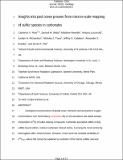Files in this item
Insights into past ocean proxies from micron-scale mapping of sulfur species in carbonates
Item metadata
| dc.contributor.author | Rose, Catherine V. | |
| dc.contributor.author | Webb, Samuel M. | |
| dc.contributor.author | Newville, Matthew | |
| dc.contributor.author | Lanzirotti, Antonio | |
| dc.contributor.author | Richardson, Jocelyn A. | |
| dc.contributor.author | Tosca, Nicolas J. | |
| dc.contributor.author | Catalano, Jeffrey G | |
| dc.contributor.author | Bradley, Alexander S. | |
| dc.contributor.author | Fike, David A. | |
| dc.date.accessioned | 2020-07-04T23:42:02Z | |
| dc.date.available | 2020-07-04T23:42:02Z | |
| dc.date.issued | 2019-09-01 | |
| dc.identifier | 259600201 | |
| dc.identifier | 4f81c6e9-b015-443e-b5c7-8272589aff30 | |
| dc.identifier | 85072026804 | |
| dc.identifier | 000483606500011 | |
| dc.identifier.citation | Rose , C V , Webb , S M , Newville , M , Lanzirotti , A , Richardson , J A , Tosca , N J , Catalano , J G , Bradley , A S & Fike , D A 2019 , ' Insights into past ocean proxies from micron-scale mapping of sulfur species in carbonates ' , Geology , vol. 47 , no. 9 , 833 , pp. 833-837 . https://doi.org/10.1130/G46228.1 | en |
| dc.identifier.issn | 0091-7613 | |
| dc.identifier.other | ORCID: /0000-0001-8149-0977/work/59464971 | |
| dc.identifier.uri | https://hdl.handle.net/10023/20207 | |
| dc.description | Laboratory work and analyses were supported by a Steve Fossett Fellowship awarded to Rose; a U.S. Department of Energy (DOE) Biological and Environmental Research grant (DE-SC0014613), U.S. National Science Foundation (NSF) grants (EAR-0951509, 1229370), an Agouron Institute (California, USA) grant, a Packard (The David and Lucile Packard Foundation, California, USA) Fellowship, and a Hanse-Wissenschaftskolleg (Germany) Fellowship awarded to Fike; and an NSF Career Grant (EAR-1056480) awarded to Catalano. Use of the Stanford Synchrotron Radiation Lightsource, SLAC National Accelerator Laboratory (California, USA), is supported by the U.S. Department of Energy, Office of Science, Office of Basic Energy Sciences under contract DE-AC02-76SF00515. GeoSoilEnviroCARS is supported by the NSF–Earth Sciences (EAR-1634415) and DOE–GeoSciences (DE-FG02-94ER14466). | en |
| dc.description.abstract | Geological reconstructions of global ocean chemistry and atmospheric oxygen concentrations over Earth history commonly rely on the abundance and stable isotopic composition (δ34S) of sulfur-bearing compounds. Carbonate-associated sulfate (CAS), sulfate bound within a calcium carbonate mineral matrix, is among the most commonly interrogated sulfur mineral phases. However, recent work has revealed variability in δ34SCAS values that cannot be explained by evolution of the marine sulfate reservoir, challenging the common interpretation that CAS is inherently a high-fidelity record of seawater sulfate. To investigate the source of this inconsistency, we used X-ray spectromicroscopy to map the micron-scale distribution of S-bearing sedimentary phases in Ordovician-aged (ca. 444 Ma) shallow marine carbonates from Anticosti Island, Québec, Canada. Clear differences in the abundance of CAS are observed between cements and fossils, suggesting that variance in bulk-rock data could be a consequence of component mixing and that coupled synchrotron-petrographic screening can identify the carbonate components that are most likely to retain primary CAS. Furthermore, we observe multiple, distinct forms of sulfate (both inorganic and organic). Differences in these forms among fossil clades could provide new insights into biomineralization mechanisms in extinct organisms. | |
| dc.format.extent | 132222 | |
| dc.language.iso | eng | |
| dc.relation.ispartof | Geology | en |
| dc.subject | GE Environmental Sciences | en |
| dc.subject | QE Geology | en |
| dc.subject | NDAS | en |
| dc.subject | SDG 14 - Life Below Water | en |
| dc.subject.lcc | GE | en |
| dc.subject.lcc | QE | en |
| dc.title | Insights into past ocean proxies from micron-scale mapping of sulfur species in carbonates | en |
| dc.type | Journal article | en |
| dc.contributor.institution | University of St Andrews. School of Earth & Environmental Sciences | en |
| dc.identifier.doi | https://doi.org/10.1130/G46228.1 | |
| dc.description.status | Peer reviewed | en |
| dc.date.embargoedUntil | 2020-07-05 |
This item appears in the following Collection(s)
Items in the St Andrews Research Repository are protected by copyright, with all rights reserved, unless otherwise indicated.

